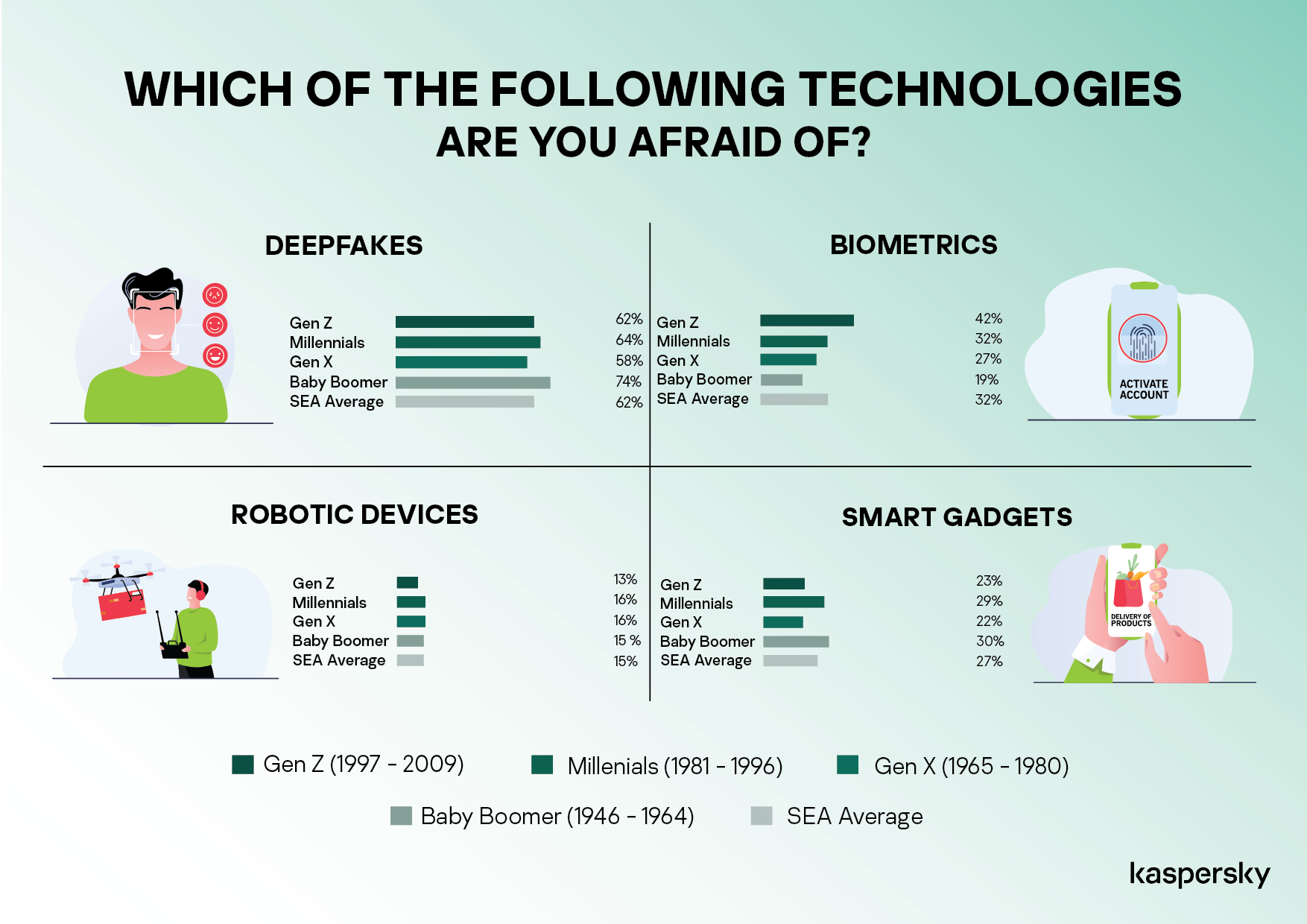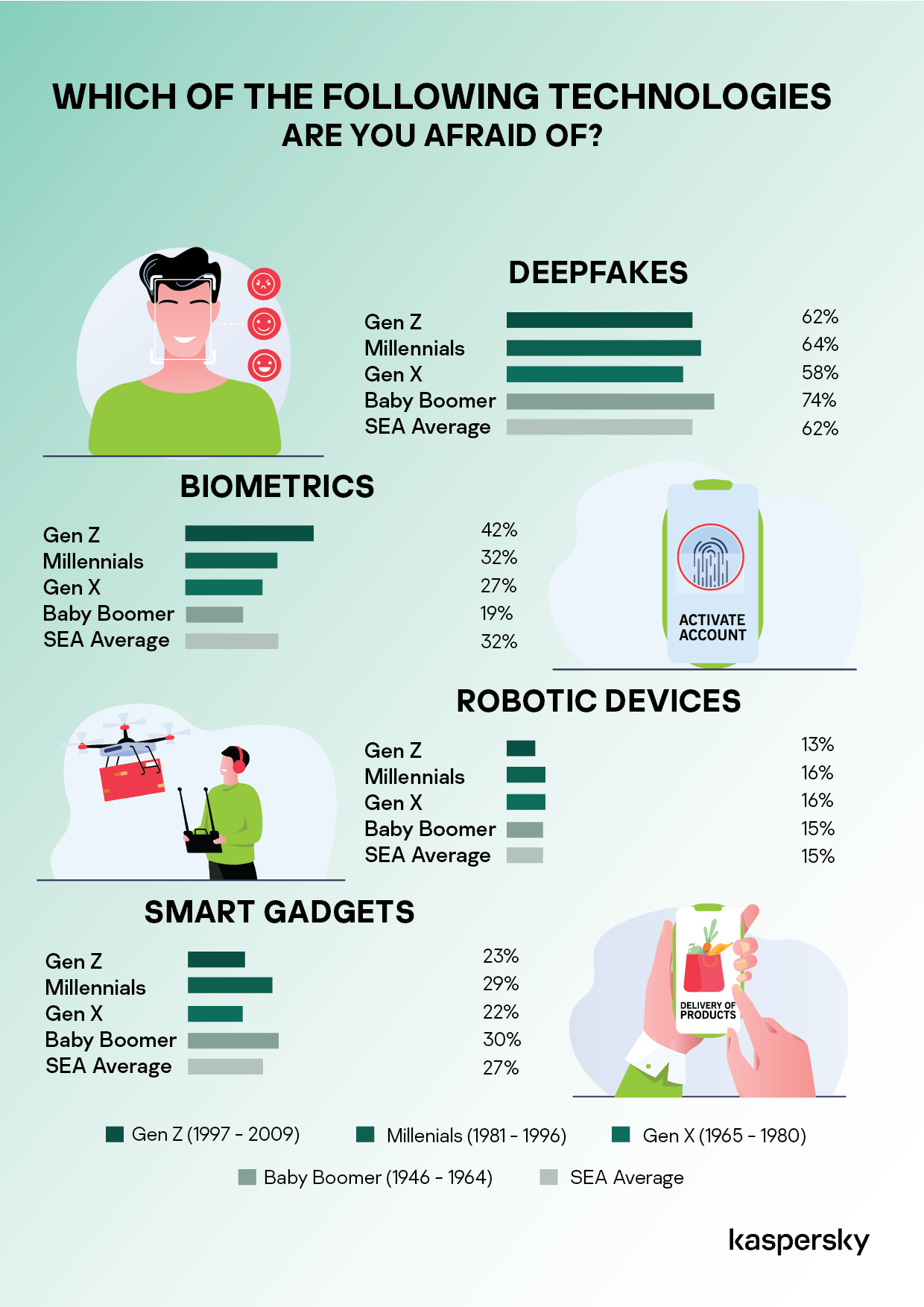Deepfakes is the use of artificial intelligence to create images, audio, or voice recordings in someone else’s likeness. The respondents’ attitude towards this technology is not without basis as deepfake videos have been used for political purposes, as well as for personal revenge. Increasingly, they are also being used in major attempts at blackmail and fraud.
For instance, the CEO of a British energy firm was tricked out of $243,000 by a voice deepfake of the head of his parent company requesting an emergency transfer of funds. The fake was so convincing that he didn’t think to check; the funds were wired not to the head office, but to a third party’s bank account. The CEO only became suspicious when his “boss” requested another transfer. This time, alarm bells rang – but it was too late to get back the funds he’d already transferred.

SEA respondents are less but still guarded about biometrics or the use of fingerprint, eye scanner, and facial recognition (32%), smart devices (27%), and robotic tools like a robot cleaner (15%).
The social media users in the region have valid reasons to fear the up and coming technologies as the study also unmasked their negative experiences online.
Most common incident faced by more than 3-in-10 respondents was an account takeover wherein someone got access to their accounts without their permission. More than a quarter (29%) also have some secret information seen by someone they would not want to see.
Over 2-in-10 also shared that someone got access to their devices forcibly (28%), their private information was either stolen or used without consent (24%) or was seen publicly (23%).
Aftermaths of these incidents include receiving spam and adverts (43%), stress (29%), causing embarrassment or offense (17%), reputational damage (15%), and monetary loss (14%).
“Our survey proves that unfortunate incidents can happen online and such have real-life repercussions. Technologies are meant to evolve for the greater good, however, there are always learning curves where some amount of fear with action will be vital,” comments Chris Connell, Managing Director for Asia Pacific at Kaspersky.
However, the same research revealed that there are still almost 2-in-10 users in the region who believe that internet security software is not required to protect their online lives. This perception is highest with Gen Z (17%), followed by Millennials (16%). There were both 15% of Gen X and Baby Boomers who also deem these solutions unnecessary.
“This is a cause of concern as we, humans, are prone to making errors from time to time and such solutions are meant to be our safety nets. While there is no silver bullet when it comes to cybersecurity, it is still important to have basic defenses in place. Business owners should particularly look into this as their IT infrastructure continues to flow from their safer enterprise networks to the more vulnerable individual houses,” adds Connell.
COVID-19 has caused an overnight remote working revolution, bringing with it new cyber-challenges for IT teams. Here’s Kaspersky’s tips on how to help homeworkers stay cyber-safe.

Teach your teams to become cyber-aware
Training is crucial to help your teams become cyber-aware. Plan a program of learning, with a mix of online learning, classroom (virtual or real-world) and regular advice by email. You could test whether people can spot a phishing attack by setting up a fake phishing email.
To start, try this free 30-minute adaptive learning course by Kaspersky and Area9 Lyceum for those who are new to remote working to help them work safely from home with lessons about choosing strong passwords, the importance of endpoint protection and regular software updates.
In the Philippines, Kaspersky is offering free e-gift vouchers (choice of Grab, GCash, or PayMaya) for every purchase of:
-
Kaspersky Total Security (valid for 1 year for 1 device) or
-
Kaspersky Internet Security (valid for 1 or 2 years for 1, 3, or 5 devices)
This promo is running until July 31, 2021. Participating Kaspersky products are available from official partner stores in Metro Manila, official partner e-stores, and via Shopee and Lazada.
Build a culture of trust
Unfortunately, in many larger organizations, there isn’t a culture of transparency between employees and IT on cyber matters. When people make mistakes, they’re either unaware of what they’ve done or are scared they’ll lose their job, so they may not formally report a data breach incident that ends up damaging the company. You need to build a culture of trust and transparency between employees and the IT team. Open communication is critical.
Advise against casual browsing on work devices
Casual browsing may lead to compromised network security, so make sure employees know this and encourage them to do personal things – like shopping, social media or reading news – on their own devices.
Patch employees’ machines
If your employees’ devices aren’t completely patched and up-to-date, the chances increase of hackers finding a vulnerability in your system. Remotely access their machine to patch or help them do it themselves over the phone. Even better, install an automated patching solution.
Ask people to change default passwords on home routers
Most home routers use a default password, which hackers can find and then get into the back end of the home network. Few people bother to change it because it’s a somewhat tricky process, but it will drastically improve employees’ cyber-defenses. Show them how they can do it.

